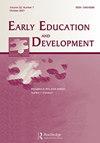Opportunities to Talk Matter in Shared Reading: The Mediating Roles of Children’s Engagement and Verbal Participation in Narrative Listening Comprehension
IF 2.1
3区 教育学
Q1 EDUCATION & EDUCATIONAL RESEARCH
引用次数: 3
Abstract
ABSTRACT Research Findings: The present study examined children’s listening comprehension during a two-semester-long dialogic reading. We explored the extent to which the development of children’s listening comprehension was accounted for by initial listening comprehension and whether children’s engagement and the amount and level of their verbal participation in shared reading contributed to their later listening comprehension. The opportunities provided by teachers, such as closed and open-ended questions were also examined. A total of 60 five-year-old children participated in 15 story groups. Children’s listening comprehension was evaluated twice. Teachers rated the children’s behavioral and cognitive engagement. Children’s verbal participation and the teachers’ questions were observed directly. A theoretical model involving direct and indirect pathways in the development of listening comprehension was analyzed. Path modeling showed that the children’s cognitive engagement and the amount of verbal participation mediated the development of individual differences in listening comprehension. Additionally, teachers’ open-ended questions contributed indirectly to listening comprehension via children’s verbal participation. Practice or Policy: The findings highlight the benefits of children’s active participation in discussions and talk-intensive reading aloud for their story comprehension.共享阅读中的谈话机会:儿童参与和言语参与在叙事听力理解中的中介作用
本文章由计算机程序翻译,如有差异,请以英文原文为准。
求助全文
约1分钟内获得全文
求助全文
来源期刊

Early Education and Development
Multiple-
CiteScore
5.50
自引率
10.30%
发文量
78
期刊介绍:
Early Education and Development (EE&D) is a professional journal for those involved in educational and preschool services and research related to children and their families: early education supervisors, school psychologists, daycare administrators, child development specialists, developmental and child clinical psychologists, and special education administrators. It is designed to emphasize the implications for practice of research and solid scientific information. The age range focused upon is preschool through the primary grades. EE&D is a connecting link between the research community in early education and child development and school district early education programs, daycare systems, and special needs preschool programs.
 求助内容:
求助内容: 应助结果提醒方式:
应助结果提醒方式:


